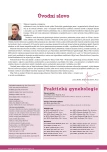Traditional peruan medicine in the therapy of sterility.
Authors:
C. F. Bazán 1; J. C. Correa 2; Tomáš Fait 3
Authors‘ workplace:
Krankenhaus Grafenau, Deutchland
Gynekologicko-porodnické oddělení Nemocnice Žatec
1; Gynekologická ambulance, Casa Grande - La Libertad, Peru
2; Gynekologicko-porodnická klinika 1. LF UK a VFN Praha
3
Published in:
Prakt Gyn 2009; 13(4): 232-233
Overview
Traditional peruan medicine in the therapy of sterility. The aim of this article is to explore possibilies of ancient peruan phytoterapy as adjuvant or alternative therapy of sterility. Efficacy of Maca and cat’s claw have demonstrated in few little studies. Personal skills of author confirm it.
Key words:
Maca – cat’s claw – phytoterapy – sterility
Sources
1. Brooks NA, Wilcox G, Walker KZ et al. Beneficial effects of Lepidium meyenii on psychological symptoms and measures of sexual dysfunction in postmenopausal women are not related to estrogen or androgen content. Menopause 2008; 15(6): 1157– 1162.
2. Dording CM, Fisher L, Papakostas G et al. A double‑blind, randomized, pilot dose‑finding study of maca root for management of SSRI‑induced sexual dysfunction. CNS Neurosci Ther 2008; 14(3): 182– 191.
3. Erowele GI, Kalejaiye AO. Pharmacology and therapeutic uses of cat‘s claw. Am J Health Syst Pharm 2009; 66(11): 992– 995.
4. García Giménez D, García Prado E, Sáenz Rodríguez T et al. Cytotoxic Effect of the Pentacyclic Oxindole Alkaloid Mitraphylline Isolated from Uncaria tomentosa Bark on Human Ewing‘s Sarcoma and Breast Cancer Cell Lines. Planta Med 2009 Sep 1. [Epub ahead of print]
5. Gonzales GF, Gonzales- Castaneda C. The methytetrahydro‑beta‑carbolines in Maca. eCAM 2008; 1– 2.
6. Gonzales GF, Córdova A, Vega K et al. Effect of lepidium meyenii, a root with aphrodisiac and fertility- enhancing properties, on serum reproductive hormone levels in adult healthy men. J Endocrinol 2003; 176(1): 163– 168.
7. Hardin SR. Cat‘s claw: an Amazonian vine decreases inflammation in osteoarthritis. Complement Ther Clin Pract 2007; 13(1): 25– 28.
8. Keplinger K, Laus G, Wurm M et al. Uncaria tomentosa – ethnomedicinal use and new pharmacological, toxicological and botanical results. J Ethnopharmacol 1999; 64(1): 23– 34.
9. Lebeda A, Doležalová I, Valentová K et al. Biologická a chemická variabilita maky a jakonu. Chem Listy 2003; 97: 548– 56.
10. Pilarski R, Bednarczyk M, Gulewicz K. Evaluation of biological activity of Uncaria tomentosa – using the chicken embryo model. Folia Biol 2009; 57(3– 4): 207– 212.
11. Reinhard KH. Uncaria tomentosa: cat‘s claw, uña de gato, or savéntaro. J Altern Complement Med 1999; 5(2): 143– 151.
12. Sathe SK, Hamaker BR, Sze- Tao KW et al. Isolation, purification, and biochemical characterization of a novel water soluble protein from Inca peanut (Plukenetia volubilis L.). J Agric Food Chem 2002; 50(17): 4906– 4908.
13. Valerio LG jr., Gonzales GF. Toxicological aspects of the South American herbs cat‘s claw (Uncaria tomentosa) and Maca (Lepidium meyenii) : a critical synopsis. Toxicol Rev 2005; 24(1): 11– 35.
Labels
Paediatric gynaecology Gynaecology and obstetrics Reproduction medicineArticle was published in
Practical Gynecology

2009 Issue 4
Most read in this issue
- Venous duct dopplerometry.
- Prognosis of women with breast cancer and sentinel lymph node micrometastases.
- Contrast enhanced ultrasound (CEUS) of impalpable breast lesions.
- Microbiological properties of endogenous vaginal flora strains in asymptomatic women of childbearing potential.
